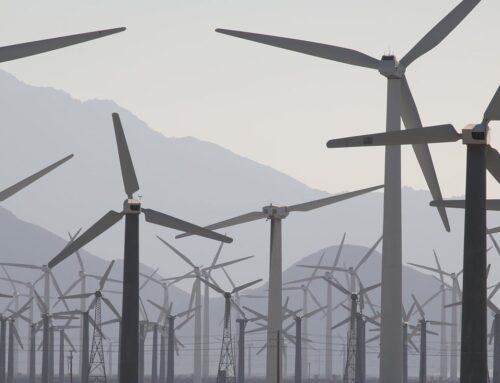What would it take to achieve an equitable transition to clean energy in Garfield County?
December 27, 2024
As the impacts of climate change worsen, some residents in the Roaring Fork and Colorado River valleys are pushing for more renewable energy, but this can be a challenge in communities such as Garfield County that have historically relied on the oil and gas industry to provide jobs and critical funding for public services such as schools, libraries and local government.
To ensure the transition to clean energy is an equitable one, state officials and local organizations are working on creative ways to help diversify regional economies and create new jobs for workers who might be impacted by the changes.
Get top headlines and KUNC reporting directly to your mailbox each week when you subscribe to In The NoCo.
Levi Doty, who grew up in New Mexico and works in geothermal energy, got his first job in the oil and gas fields when he was 19.
“My uncle told me they were paying $28 an hour to start. And I said, ‘Where do I sign up?’” Doty said.
Doty loved the job and the high pay, but it could be isolating working in remote parts of Texas and New Mexico, and the work was unpredictable, taking him to boomtowns as oil and gas prices fluctuated.
“You could be going full blown for six months, then, all of a sudden, it dropped, and everybody was like, ‘Bye, go home, we’re done,’” Doty said. “I can’t do that, but you ain’t got no choice.”
A year and a half ago, after about 18 years in and out of the oil and gas industry, Doty decided to apply for a job with the Colorado-based geothermal company PanTerra Energy.
Although he had to learn some new skills, his previous drilling experience helped him a lot, and he now prefers working at a smaller company that provides steady work and more travel opportunities.
“I get to see places like Aspen, Glenwood, Grand Junction and also Kentucky, Illinois, Nevada, North Dakota, California, Montana,” Doty said. “I’ve been to quite a few places and the best part is: It’s on the company, so you’re getting paid to travel.”
Eleanor Bennett
/
Aspen Journalism and Aspen Public Radio
According to a recent Garfield County Economic Update from the Davis School of Business at Colorado Mesa University (CMU), oil and gas jobs grew significantly in the county in the mid-2000s, and have since been declining over the past 15 years, falling below 1,000 in 2023 from roughly 3,000 jobs in 2008.
The Colorado Department of Labor and Employment, which tracks statewide jobs data, reports that Garfield County’s current quarterly average employment for the oil and gas industry is 430 jobs.
An economic analysis by the nonprofit research institution Resources for the Future also found that drilling in the county peaked in 2008 and subsequently declined due to decreasing natural gas prices and new shale opportunities in the southern U.S. that steered drilling rigs away from western Colorado.
In Garfield County’s 2024 budget, government is listed as the No. 1 industry, followed by construction, retail trade, accommodation and food services, and health care services. The recent economic update from CMU’s business school lists “mining, quarrying, and oil and gas extraction” jobs as the 12th-largest industry in the county.

Garfield County
/
Colorado Department of Local Affairs
Wade Buchanan leads Colorado’s Office of Just Transition, which was created by state legislators in 2019 and was one of the first of its kind in the country.
Although the legislation that created the office was focused on helping coal communities prepare for the state’s effort to combat climate change and phase out coal mines and coal-fired power plants, lawmakers could direct the office to work with oil and gas communities in the future.
Buchanan and his team have been meeting with coal workers, their families and community members to understand the challenges they face, including job security.
“They are proud of what they do, and they should be,” Buchanan said. “They’ve kept the lights on, they have fueled our prosperity for decades and now they’re told that they need to make this major sacrifice. Not all of them are bought into it, and not all of them, frankly, trust the state government.”
As a former industry worker, Doty doesn’t want to see coal or oil and gas go away, and he doesn’t believe in government handouts, but he is glad there’s a state group helping look out for workers.
“It would be nice for the government to make sure all the blue-collar workers stay working and keep food and stuff for their kids instead of helping just the rich people,” he said.
A new report released this week from the nonprofit Colorado Fiscal Institute surveyed 34 oil and gas workers and 222 community members, including in Garfield County, about the impacts of transitioning to renewable energy in Colorado. It found that many people had similar views to Doty when it came to prioritizing job quality and support for workers, including those transitioning to new careers.
Doty would also like to see more government support for a greater diversity of energy industries, including geothermal.

Eleanor Bennett
/
Aspen Journalism and Aspen Public Radio
Last fall, PanTerra Energy, the company where Doty now works, helped with test drilling for a proposed geothermal site outside the Third Street Center in Carbondale.
The original idea for the project was to create a shared energy district in Carbondale that focused on heating and cooling a group of already existing buildings, including the Third Street Center, the Carbondale Library and the Second Street Townhomes, with geothermal energy instead of natural gas.
Clean Energy Economy for the Region (CLEER), the nonprofit behind the project, found out this week that it was not selected to receive a major grant from the U.S. Department of Energy for about $18 million, but it plans to explore other funding options and the possibility of including new buildings that are easier to retrofit.
“Once you get the system set up, especially on a district scale, it would be a more stable energy cost where it’s not at the mercy of the fluctuating natural gas market,” said Alice Laird, who runs CLEER and its partner program, Garfield Clean Energy.
The proposed geothermal system would use underground pipes that heat water in winter and cool it in summer using the earth’s natural temperature.
In addition to lowering energy costs and carbon emissions, Laird sees the project as part of a wider effort to provide jobs for people such as Doty, and diversify the local economy.
“We need to be very empathetic to communities and entities that currently receive a large share of funding that’s derived from oil and gas or fossil fuel industries,” Laird said.
From 2003 to 2009, oil and gas property grew from roughly 30% of Garfield County’s tax base to more than 70%, according to the Resources for the Future report.
And although oil and gas production has since been declining in the region for more than a decade, Garfield County is still the second-largest producer of natural gas in the state and 59% of assessed property value in the county was categorized as oil and gas last year.
That tax base helps fund important services, including the county government and public schools, hospitals and fire districts.
Although the county has also become a leader in certain renewables such as solar, Laird said the shift requires rethinking fiscal and tax policies.
“It would be very challenging to take solar energy and geothermal and change our tax policy so that it would generate the same amount of revenue as the oil and gas industry,” Laird said.
Laird and Buchanan agree that diversifying local economies is critical.
“The reason these economies are in danger is that they’re overly dependent on one sector, and that is a very common rural economic challenge,” Buchanan said. “It just happens to be in energy right now, but it could just as easily be agriculture, private prisons, you know, a ski resort.”
Buchanan’s team has started helping communities identify, and fund, new ways to generate tax revenue and good paying jobs, such as expanding businesses and creating new ones.
“We’ve been able to make some progress, and I think we’ve been able to build good relationships,” Buchanan said. “There’s one family up in Moffat County that is starting a geothermal business, and we’ve been able to be a significant assistance to them in terms of making connections and helping with some training and resources.”
As for Doty, he is not concerned about climate change, but he appreciates that a less-damaging energy source such as geothermal is becoming more popular.
“You’re using Mother Nature to help you, but it’s not destroying Mother Nature. You’re putting it right back to the state that you came into it on,” Doty said.
Laird and her team at CLEER agree, and they’re hopeful they can get enough funding to work with geothermal drillers such as Doty to create a new source of sustainable energy for the community.
This story was produced through a social justice reporting collaboration between Aspen Journalism and Aspen Public Radio. It’s also the final segment in Aspen Public Radio’s three-part series, “Finding a Fix: Investigating Local Solutions to Big Climate Challenges.” The series is supported by a grant from the Aspen Skiing Company’s Environment Foundation.
Copyright 2024 Aspen Public Radio
Search
RECENT PRESS RELEASES
Related Post




